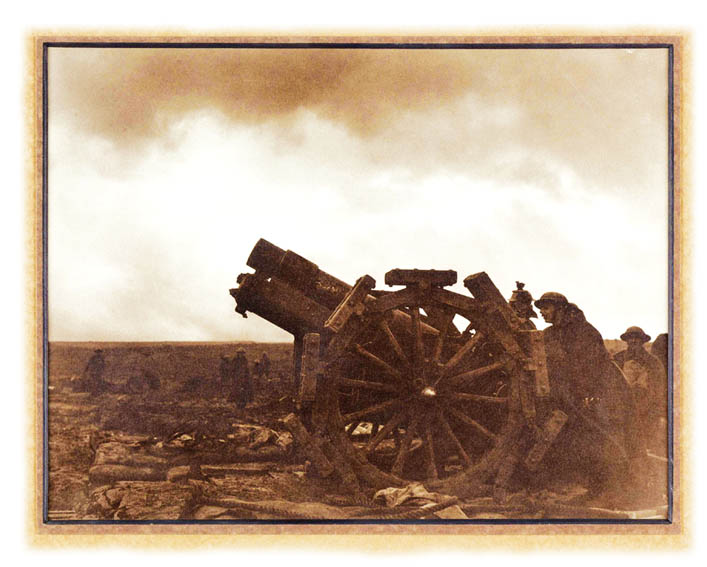
A six inch Howitzer similar to that operated by Frederick Wells and the 113th Siege Battery during the Battle of
Passchendaele in October 1917. (Frank Hurley)
Frederick was the youngest son of Arthur and Jane and, in 1911, he was working as a bricklayer’s labourer. In 1913, Fred married Mary Akers and moved to Woodbridge where they had two children. It was not until 1916 that Fred was called up to join the war effort; he was posted the newly-raised 113th Siege Battery of the Royal Garrison Artillery (RGA). The battery was based in Horsham, Kent, for their initial training before being moved to Lydd in April 1916 for practice firing and additional training. On 10th June 1916, the battery received its orders to mobilise to France, taking their four six-inch Howitzers with them. On arrival in France, Fred’s battery joined the 31st Heavy Artillery Group on the Somme where they remained until October 1917. Their Commanding Officer, Major Harold Allen DSO (Distinguished Service Order), says in his diary of their time at the Somme:
“I find it unbelievable that the guns were used so much from that time during the Somme that by 28th December the two right section guns were condemned and that section went to rest. Through similar use the left section guns were condemned and sent to base on 23rd January 1917 and the battery had no guns until 5th February 1917.”
On 4th October 1917, the left-hand section of the 113th Siege Battery was moved north to the Ypres area to support the infantry during the Third Battle of Ypres, with the righthand section joining them nine days later on the 13th.
On 9th October, the battery was in position at Witte Poort Farm, half a mile east of the notorious Hell Fire Corner, when the Battle of Poelcappelle began. It was recorded in their war diary that they fired two hundred and ninety-one rounds in a barrage lasting from 05:20 until 10:50. Later that evening, Fred’s battery received orders to take up a new position at Westhoek, which was completed in time for the arrival of the right-hand section on the 13th. The following day, the guns were used for the first time since their move, alerting the enemy of their position. On the 15th the war diary reported:
“Heavy shelling during the day with 5.9 and 8 inch High Explosive (shells) resulted in two guns being placed out of action – one with a direct hit which left it with the muzzle touching the ground and the tail perpendicular, and the other by a splinter that damaged the sight carrier.”
Eight men were killed and twenty-three wounded during the shelling of their position. Fred was amongst the casualties and was taken to the 2nd Canadian Casualty Clearing Station at Remy sidings near Langermarck where, on the 26th October 1917, he died of his wounds.
Frederick is remembered on Woodbridge War Memorial and is buried in the Lijssenthoek Military Cemetery. For his war service Frederick’s family received the British War and Victory Medals.
